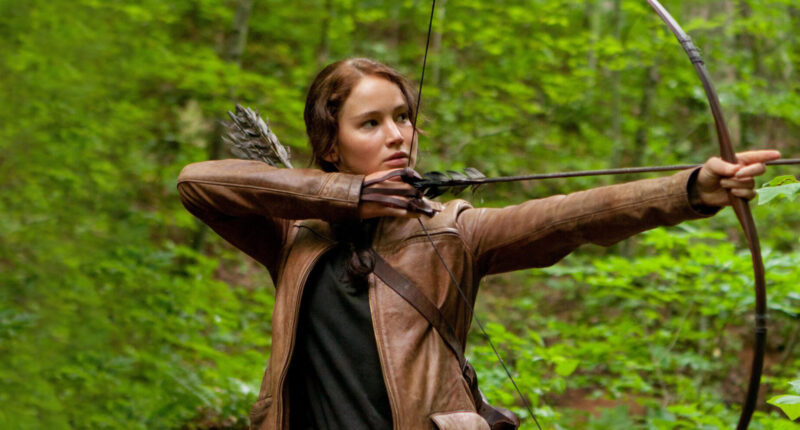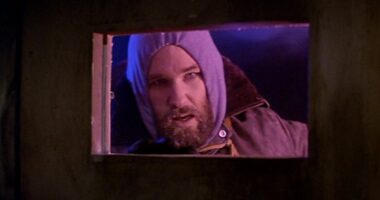Share this @internewscast.com
Back in 2008, Suzanne Collins — who, at the time, was known for her work on shows like “Clarissa Explains It All” and books including “The Underland Chronicles” — revolutionized young adult literature with “The Hunger Games.” Inspired by Greek mythology, Roman gladiators, and the blending of reality TV with active warfare that was evident in the early 2000s, Collins shared with the New York Times that the idea struck her suddenly and naturally. “I was channel surfing between reality shows and actual Iraq War footage when it hit me,” she explained to David Leviathan in 2018, six years after the last film in the original series. So, what is the concept, if by some chance you haven’t encountered it?
In Collins’ dystopian reimagining of North America, known as Panem, society is divided into twelve districts, each providing vital resources to the nation’s infrastructure. These districts, mainly impoverished, are ruled by the Capitol, which, after quashing a rebellion termed the “Dark Days,” instituted the titular Games. Annually, 24 children, a boy and girl from each district aged 12 to 18, are selected by lottery, and only one survives this deadly contest; this entire spectacle serves to remind the districts that the Capitol holds all the power.
The original trilogy is centered around Katniss Everdeen, portrayed on-screen by Jennifer Lawrence — a young girl from District 12, a coal-mining district, whose secretive hunting kills help her family survive under the Capitol’s scant provisions. Following these three books, Collins has significantly broadened Panem’s narrative with several prequels and shows no sign of stopping. So how do the “Hunger Games” books rank from least to most impressive? It’s crucial to note: all of these books are excellent. Collins excels at creating immersive worlds and compelling narratives, with her expansions of the “Hunger Games” universe yielding remarkable tales, making this list more about comparative greatness than quality. May the odds be ever in your favor, literary fans! And beware of spoilers!
5. The Ballad of Songbirds and Snakes
2020’s “Ballads of Songbirds and Snakes,” the first “Hunger Games” prequel, isn’t a misstep by any means; however, it focuses on one of the series’ least likable figures: Coriolanus Snow. In his youth, the future President of Panem is simply surviving as part of the failing Snow family when he is tapped to mentor a tribute in the 10th Annual Hunger Games, courtesy of his student status at the Capitol Academy. Hoping to emerge successful and prove the family dictum “snow always lands on top,” Coriolanus is less than thrilled when he draws District 12, often seen as the weakest due to its extreme poverty.
Thanks to some ill-conceived publicity stunts by the Academy and Capitol, several tributes perish before reaching the arena; however, Coriolanus’ assigned tribute, Lucy Gray Baird, proves to be quite capable. As a performer, she charms the audience, sparking the concept that sponsors can support favored tributes with gifts. Although not physically strong, Coriolanus manipulates events (or blatantly cheats) to her advantage. Ultimately, Lucy Gray triumphs, yet the path she and Coriolanus follow post-Games is arguably darker than the Games themselves — shedding light on Snow’s animosity towards strong-willed District 12 girls like Katniss. (In the 2023 film adaptation, Tom Blyth and Rachel Zegler portray Coriolanus and Lucy Gray.) “Ballad” is a superb character exploration, yet navigating Coriolanus’ malevolent psyche is complex … which is undoubtedly what Suzanne Collins anticipated.
4. Mockingjay
It’s difficult to place “Mockingjay,” the concluding book of Collins’ original trilogy released in 2010, so low on the list. It’s a fitting end to Katniss Everdeen’s saga, but in true Collins fashion, it’s intensely somber; she masterfully crafts ways to beset and afflict characters in distressing ways. (Consider that a compliment.) Rescued from the “Catching Fire” arena, Katniss is outraged to learn that her trusted ally and erstwhile romantic interest, Peeta Mellark, portrayed by Josh Hutcherson in the films, remains captive in the Capitol while she and others like Finnick Odair (played by Sam Claflin on screen) take refuge in the covert District 13. There, Katniss joins forces with her childhood friend and former “boyfriend” Gale Hawthorne (Liam Hemsworth in the movies) and the resistance, aiming to topple the Capitol, but it’s infinitely more nuanced — especially given Katniss’ predictably inadequate media presence as the revolution’s figurehead.
“Mockingjay” can be unrelentingly bleak at times, sure — Finnick’s agonizing death is a real lowlight, and the third-act twist involving Gale and Katniss’ sister will make your heart fall into your butt — but by the time you reach the stunning and deeply disturbing epilogue where Katniss details the trauma she carries with her years after the Games, it all does make sense. War is brutal, and Collins never shies away from that for a second; honestly, that impulse on the author’s part just makes for a better book. Beyond that, Collins is always careful to remind us — and Katniss — that enemies can exist on both sides of the war, particularly as Katniss has to look between the evil President Coriolanus Snow (played in the original films by Donald Sutherland) and the shady president of District 13, Alma Coin (Julianne Moore on screen) and decide which of them is lying to her.
3. The Hunger Games
The book that basically kicked off the young adult dystopian craze of the aughts and 2010s is really, really good, but it also says a lot about the series as a whole that it’s only ranked third on this list. When “The Hunger Games” opens, Katniss and her mother and sister are barely scraping by in District 12 — and despite Katniss and Gale’s illegal hunting, both of them are forced to take food packages from the Capitol called “tesserae” that increase their odds of getting picked for the Games. Still, despite Katniss’ best efforts to keep her sister Primrose, played in the movies by Willow Shields, safe from the Reaping that chooses children for the Games, Prim’s name is chosen by the Capitol’s effervescent representative Effie Trinket (Elizabeth Banks on-screen). Without hesitating, Katniss volunteers as “tribute” in Prim’s place, and alongside the baker’s son Peeta Mellark, she heads to the Capitol to prepare for the 74th Games.
At first, Katniss and Peeta seem pretty much doomed. Their mentor Haymitch Abernathy (Woody Harrelson in the films), one of the only surviving and known District 12 victors in history, isn’t enthusiastic about their chances, especially compared to the “career” tributes basically bred to succeed in the Games that usually hail from Districts 1 and 2. Thanks to Katniss’ prowess with a bow and arrow and Peeta’s camouflage skills, they enter the Games fairly prepared … and their “false” dynamic as doomed star-crossed lovers, created largely by Peeta in the lead-up to the Games, helps win over the audience.
Eventually, Katniss and Peeta’s bond, such as it is, forces the hand of the Gamemakers and President Snow, and the rules change — allowing two players from the same district to claim victory. Though the Capitol desperately tries to reverse this decision when Katniss and Peeta both survive, Katniss threatens to kill them both with poison berries, leaving the Games without a victor at all … and when they both win, it sets the rest of the series into motion (and sets up a larger battle between Katniss and Snow to boot). “The Hunger Games” is gripping, propulsive, and told through the perspective of an understandably bristly and stubborn teenage girl; if you haven’t read it, change that immediately.
2. Sunrise on the Reaping
Released in 2025, “Sunrise on the Reaping” takes place between “The Ballad of Songbirds and Snakes” and “The Hunger Games,” somewhat — and details Haymitch Abernathy’s victory in the 50th Annual Hunger Games, also known as the Second Quarter Quell. (A “Quarter Quell” takes place every 25 Games and adds in a vicious twist as a horrifying special “treat,” and we’ll return to the Third Quarter Quell, the 75th Games, pretty soon.) The twist during the 50th Games is that instead of 24 tributes, the number is doubled, meaning four kids from each district will compete and bring the total number of players to 48.
This is brutal enough, but anyone’s who’s read “Sunrise on the Reaping” knows the number of tributes is just the tip of the cruelty iceberg. Haymitch isn’t actually chosen during the District 12 reaping, but after a different kid tries to escape and is killed when his name is called, Haymitch ends up abruptly chosen by the Capitol’s representatives. From there, the horrors barely cease. One of Haymitch’s fellow tributes, Louella McCoy, dies when chariots collide during the traditional opening tribute parade; she’s replaced by a look-a-like Haymitch dubs “Lou Lou” who has no idea where she is, let alone that she’s participating in the Games. Because there are no known District 12 victors — Lucy Gray Baird is long gone by this point and disappeared after the events of “The Ballad of Songbirds and Snakes” anyway — Haymitch is mentored by District 4’s Beetee, a character we first met in the “Hunger Games” books who’s played by Jeffrey Wright in the movies … and as punishment for apparent wrongdoing, Beetee’s son Ampert is one of District 4’s tributes. “Sunrise on the Reaping” is a shockingly necessary, deeply dark, and utterly riveting look at a character we love from the original books, and it proves that, for as long as Suzanne Collins wants to, she can keep expanding this world’s lore.
1. Catching Fire
“Catching Fire,” which hit shelves in 2009, is both the best book and film in the franchise as of this writing, which is pretty remarkable when you consider that second books usually suffer from a sophomore slump — making this installment the “Empire Strikes Back” of the original trilogy. After their shared victory in the 74th Games, Peeta and Katniss deal with new responsibilities, including a post-Game tour of the districts … and in the process, they realize rebellion is clearly brewing throughout Panem. As punishment for the potential uprising Katniss inspired with her berry-related trick, the rule for the Third Quarter Well is meant to attack her: specifically, President Snow decrees that only previous victors can compete in the 75th Games. This puts Peeta and Katniss back into the arena for the second time in a row alongside other fellow victors from other districts, like Beetee, Finnick, and other newcomers to the story like Johanna, Wiress, and Mags (played in the films by Jena Malone, Amanda Plummer, and the late Lynn Cohen).
After a series of horrifying events — including the murder of Katniss’ friend and stylist Cinna, played onscreen by Lenny Kravitz — the former winners enter the arena only to discover that it’s the world most sinister clock, bringing new deadly events in different sections of the map with each new hour. Amidst it all, there’s a plan for escaping the arena, and though Katniss fires the arrow makes escape possible, she doesn’t exactly realize what she’s done until she wakes up in a hospital room. At the end of the book, Katniss learns that she’s in District 13, giving readers an enormous cliffhanger … and the story leading up to that finish is the most gripping in the series.









